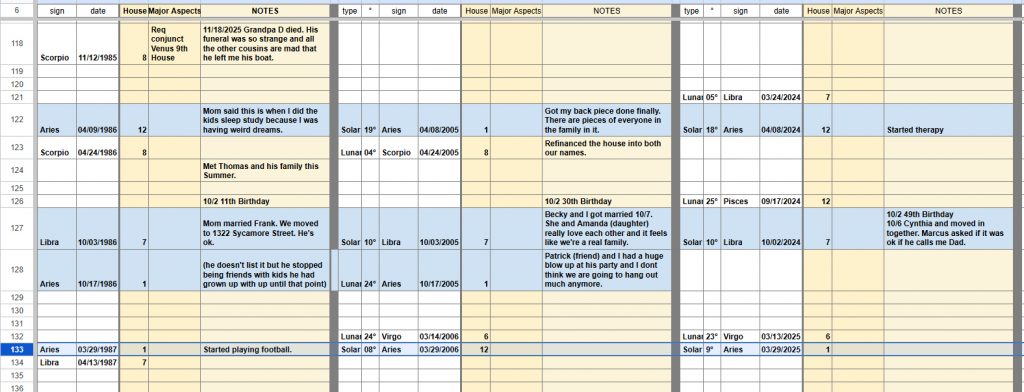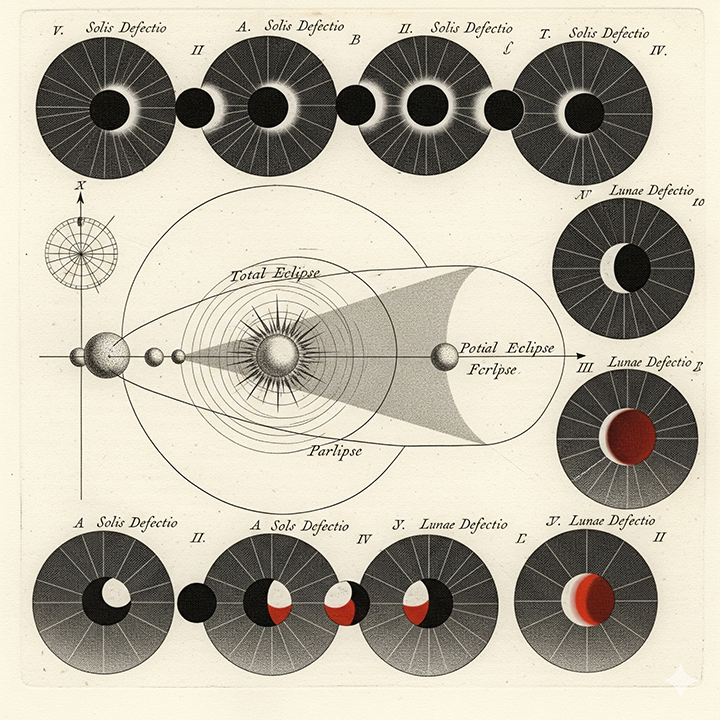This article is Part 3 in a three-part series on eclipses. Part 1: Course Corrections introduced eclipses as course corrections written into life’s rhythm. Part 2: Solar vs Lunar explained the difference between eclipse types and how they operate through the nodes. Let’s get to how you actually use the eclipses to track what’s happening in your life.
To begin tracking eclipses, you will need a few things. Start with your natal chart. If you don’t have one yet, create a free account at Astro.com, and make one there. If you also have a progressed chart, use it, but the natal alone is enough. Be sure your chart includes the asteroids that matter to you. Then use the list of eclipse dates linked here. These are the map.
How I recommend setting up Astro.com.
Astro.com, also known as Astrodienst, has been the industry standard for free astrology software for decades. Since the mid-1990s, it has provided some of the most accurate chart calculations available online. The site runs on the Swiss Ephemeris, a professional-grade astronomical data system trusted worldwide for its precision.
Professional astrologers use Astro.com daily because the software is reliable, the math is exact, and the options are extensive. If you’ve heard that an astrologer “pulled up your chart,” chances are they used Astro.com or software built on the same foundations.
To run a natal chart, go to www.astro.com in your browser.
If you are experimenting you can use the “Guest User” option, but creating a free account is useful because your birth data will be saved for later.
Enter your name, date of birth, time of birth, and place of birth.
The time matters a great deal but even without it you can cast an accurate chart.
A chart without a birthtime will still show all of the same planetary placements, though the moon may vary some, but your Ascendant and house positions will not be shown.
Always use the time from your birth certificate if possible, but do not guess.
If you do not know, select Unknown.
Once your information is entered, save it and go to “Extended Chart Selection,” the page where you will choose chart types, customize settings, and add asteroids.
Choose “Natal Chart Wheel.”
For Chart Drawing Style select “Astrodienst w. asteroids” and set the date you want to look at.
Under Zodiac and Houses leave the default settings as they are with the Tropical zodiac and Placidus house system unless you know you want something else.
In Display and Calculation Options select True Node, Descending Node, six Fixed Stars in zodiac, to Chiron, to lunar node and eclipses, to all objects, and only major aspects (0, 180, 90, 120, 60°).
Set Reduce/Increase Orbs to 40%.
Set image size to 100%.
Choose Landscape if possible.
Adjust planet position marks.
Under Common Elements select Pars Fortunae and Vertex.
Clicking on “Asteroid name/number list with 25560 names” will open a menu that allows you to search for specific asteroids alphabetically.
When everything is set, click “Show the chart.”
Your chart will load instantly and you should click “Save default settings” so these choices will be retained the next time.
The wheel that appears is your natal chart, divided into twelve houses with the zodiac around the edge, planetary symbols placed in the houses, and colored lines connecting them across the middle.
When you return to the Extended Chart Selection page you can experiment with other options such as choosing “Natal and Transits” to overlay current planetary positions or adding asteroids by entering their numbers into the “Additional Objects” box.
It is important to understand that there are multiple eclipse cycles happening all at the same time. Each axis period, or time spent in each pair of signs, lasts roughly 18 months, sometimes two years, with eclipses bouncing back and forth between the two opposing signs. We are currently in an axis period of Virgo and Pisces eclipses. These are the immediate stories, the doors opening and closing while the axis is active. At the same time, each eclipse belongs to the longer 18.5-year return cycle. The same degree will repeat, usually for four or five passes, before it falls out of sequence. These long cycles are the chapters across decades. They are not identical events, but they carry the same themes forward.
The eclipses echoing in 2025 also have links to 2006, and also 1987. The storyline is familiar, but the role will often change. You may have been a child at the first turn, the parent to a child dealing with a similar situation at the second, and the elder advising an adult dealing with a child going through the same situation at the third. The axis cycles tell you what is happening now. The 18.5-year returns show you how far the story has advanced.
Once you have your charts and dates, the first step is to place each eclipse degree into your houses. This shows where the story is unfolding. An eclipse in your 1st house will alter your identity or body. In the 4th, your home and family. In the 7th, your partnerships. In the 10th, your career and public role. Houses are the stage where the event plays out.
Next, look to the planets and asteroids close to those degrees. An eclipse conjunct your Sun highlights ego, identity, and vitality. Conjunct your Moon, it pulls at home, family, patriotism, and emotional security. Mercury points to communication and travel. Venus to self-worth, relationships, and money. Mars to drive, conflict, and desire. The outer planets carry collective weight but still matter when touched. Asteroids sharpen the story: Juno for commitment, Ceres for mother/smother, Chiron for wounds, Vesta for devotion
By applying Star Math we layer the pieces together.
The house gives the stage. The planet or asteroid gives the actor, and the costumes they will wear.
Example 1: A solar eclipse in your 7th house conjunct Venus may begin a relationship or shift the terms of an existing one.
Solar Eclipse – Beginning a 6-month stage of the 18.5-year cycle, that will conclude with the corresponding Full Moon/Lunar Eclipse in the same sign.
7th House – It will apply to your relationships, romantic or otherwise.
Conjunct – Merging with.
Venus – It will involve or impact your self-worth, money you earn, how you spend and save, or how you feed yourself or your family.
Example 2: A lunar eclipse in the 10th house conjunct Saturn may end a career chapter, finalize a responsibility, or mark the conclusion of a long struggle with authority.
Lunar Eclipse – Ends or concludes a 6-month stage that began with the corresponding New Moon/Solar Eclipse of the same sign.
10th House – It will be seen by everyone and may impact or involve your career, or your dominant and protective parent. Usually the father, but in many cases you will find evidence of the mother in the 10th house as well.
Conjunct – Merging with.
Saturn – Responsibilities, restriction, consequences, and authority. It represents the weight of time, the boundaries that hold, and the lessons that cannot be avoided.

Then trace the echoes. Look back eighteen years for the prior eclipse at that degree. Look forward to see if there is another eclipse in the cycle. If so, each one belongs to the same storyline. Write down what began, what ended, who entered, who left. Even if you don’t believe it relates to the storyline, write down whatever notes you can remember about that time period. Over time you will see the architecture of your karmic cycles.
Remember that eclipses overlap. While one axis is closing, another has already begun, several are active at the same time. That is why eclipse seasons feel heavy. In 2024 and 2025, the Aries–Libra eclipses are closing chapters on balance and partnership while the Virgo–Pisces eclipses have begun stories of health, service, and faith. You may feel pulled in two directions because you are living two storylines at once.
The nodes carry the karmic load. The South Node pulls back the past, reviving patterns, debts, and unfinished business from eighteen years ago. The North Node pushes forward, opening fated events that demand growth and lay down new karma. Every eclipse is tied to one or the other. South Node eclipses resurface what was. North Node eclipses carve what must be. Both are part of the same design.
Working with eclipses is not about control. I do not recommend trying to manifest with them. You watch, you record, you trace the line. By mapping the degrees, the houses, the planets, and the echoes, you learn the rhythm. You see the pattern instead of being caught off guard each time the floor drops.
Eclipses are deadlines, but they are also the outline of your life. When you work with them, you stop treating them as accidents. You begin to see the sequence, chapter by chapter, cycle by cycle, until the story comes into view.
What’s Next
With the eclipse series complete, the focus shifts to Venus in Leo. August 25, 2025 – September 19, 2025. Venus here magnifies self-expression, love, and value through pride and visibility. It pushes relationships into the spotlight, testing whether affection and loyalty are genuine or performative. Money and beauty choices also tilt dramatic, what you spend on, how you present yourself, what you want seen.
Venus in Leo asks for confidence without arrogance, generosity without strings. It is a transit that rewards courage in love and creativity, but also exposes vanity and shallow pursuits. Over the weeks ahead, expect themes of romance, friendship, and finances to flare with Leo’s fire, reminding you that what you value most should be lived out loud.

